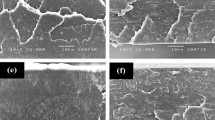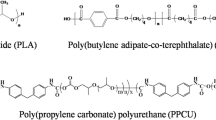Abstract
This study investigated the effects of natural rubber (NR) and an organic peroxide on the rheological properties, mechanical properties, morphology, and bubble stability during film blowing of poly(lactic acid) (PLA). The NR and peroxide contents were varied from 0 wt% to 25 wt% and 0 wt% to 0.5 wt%, respectively. The results confirmed that the presence of well-dispersed NR could significantly improve the toughness, elongation at break, and processability of PLA films, where the optimal amount of NR was 15 wt%. For the reactive blending with peroxide, a suitable peroxide content for good film toughness and clarity was 0.03 wt%, while the higher content of 0.1 wt% could provide slightly higher processability. These contents are considered much lower than that in the PLA system (without NR), which required up to 0.5 wt% peroxide. The rheological studies indicated that the melt strength, the storage modulus (G′) and complex viscosity (η′) at low frequency could be correlated with good film blowing processability of the PLA/NR films at low gel contents. These parameters failed to correlate in the films having high gel contents as the deformation rate experienced by each test was different leading to the different levels of response to the type and amount of gels.
Similar content being viewed by others
References
Mallet, B.; Lamnawar, K.; Maazouz, A. Improvement of blown film extrusion of poly(lactic acid): structure-processing-properties relationships. Polym. Eng. Sci. 2014, 54, 840–857.
Karkhanis, S. S.; Stark, N. M.; Sabo, R. C.; Matuana, L. M. Blown film extrusion of poly(lactic acid) without melt strength enhancers. J. Appl. Polym. Sci. 2017, 134, 45212.
Al-Itry, R.; Lamnawar, K.; Maazouz, A. Biopolymer blends based on poly(lactic acid): shear and elongation rheology/structure/blowing process relationships. Polymers 2015, 7, 939–962.
Ding, Y.; Lu, B.; Wang, P.; Wang, G.; Ji, J. PLA-PBAT-PLA tri-block copolymers: effective compatibilizers for promotion of the mechanical and rheological properties of PLA/PBAT blends. Polym. Degrad. Stabil. 2018, 147, 41–48.
Wu, N.; Zhang, H. Mechanical properties and phase morphology of super-tough PLA/PBAT/EMA-GMA multicomponent blends. Mater. Lett. 2017, 192, 17–20.
Nofar, M.; Salehiyan, R.; Ciftci, U.; Jalali, A.; Durmuş, A. A. Ductility improvements of PLA-based binary and ternary blends with controlled morphology using PBAT, PBSA, and nanoclay. Compos. B. Eng. 2020, 182, 107661.
Nyambo, C.; Misra, M.; Mohanty, A. K. Toughening of brittle poly(lactide) with hyperbranched poly(ester-amide) and isocyanate-terminated prepolymer of polybutadiene. J. Mater. Sci. 2012, 47, 5158–5168.
Suparanon, T.; Surisaeng, J.; Phusunti, N.; Phetwarotai, W. Synergistic efficiency of tricresyl phosphate and montmorillonite on the mechanical characteristics and flame retardant properties of polylactide and poly(butylene succinate) blends. Chinese J. Polym. Sci. 2018, 36, 620–631.
Gu, X.; Hu, L.; Fu, Z.; Wang, H.; Li, Y. Reactive TiO2 nanoparticles compatibilized PLLA/PBSU blends: fully biodegradable polymer composites with improved physical, antibacterial and degradable properties. Chinese J. Polym. Sci. 2021, 39, 1645–1656.
Zhang, W.; Yu, Z.; Yanmo, C. Modified brittle poly(lactic acid) by biodegradable hyper branch poly(ester amide). Iran. Polym. J. 2008, 12, 891–898.
Huang, J.; Mou, W.; Wang, W.; Lv, F.; Chen, Y. Influence of DCP content on the toughness and morphology of fully biobased ternary PLA/NR-PMMA/NR TPVs with co-continuous phase structure. Polym-Plast. Tech. Mat. 2020, 59, 674–684.
Sathornluck, S.; Choochottiros, C. Modification of epoxidized natural rubber as a PLA toughening agent. J. Appl. Polym. Sci. 2019, 48267
Triampanichkul, N.; Boochathum, P. Hydroxylated natural rubber effect on crystallinity and mechanical properties of PLA. Key Eng. Mater. 2019, 798, 310–315.
Phattarateera, S.; Pattamaprom, C. The viscosity effect of masticated natural vs. synthetic isoprene rubber on toughening of polylactic acid. Int. J. Polym. Sci. 2019, 5679871
Phattarateera, S.; Pattamaprom, C. Comparative performance of functional rubbers on toughness and thermal property improvement of polylactic acid. Mater. Today Commun. 2019, 19, 374–382.
Pattamaprom, C.; Chareonsalung, W.; Teerawattananon, C.; Ausopron, S.; Prachayawasin, P.; Van Puyvelde, P. Improvement in impact resistance of polylactic acid by masticated and compatibilized natural rubber. Iran. Polym. J. 2016, 25, 169–178.
Jaratrotkamjorn, R.; Khaokong, C.; Tanrattanakul, V. Toughness enhancement of poly(lactic acid) by melt blending with natural rubber. J. Appl. Polym. Sci. 2012, 124, 5027–5036.
Pongtanayut, K.; Thongpin, C.; Santawitee, O. The effect of rubber on morphology, thermal properties and mechanical properties of PLA/NR and PLA/ENR blends. Energy Proc. 2013, 34, 888–897.
Xia, S.; Liu, X.; Wang, J.; Kan, Z.; Chen, H.; Fu, W.; Li, Z. Role of poly(ethylene glycol) grafted silica nanoparticle shape in toughened PLA-matrix nanocomposites. Compos. B Eng. 2019, 168, 398–405.
Zhang, C.; Wang, L.; Zhai, T.; Wang, X.; Dan, Y.; Turng, L. S. The surface grafting of graphene oxide with poly (ethylene glycol) as a reinforcement for poly(lactic acid) nanocomposite scaffolds for potential tissue engineering applications. J. Mech. Behav. Biomed. Mater. 2016, 53, 403–413.
Behera, K.; Chang, Y. H.; Yadav, M.; Chiu, F. C. Enhanced thermal stability, toughness, and electrical conductivity of carbon nanotube-reinforced biodegradable poly(lactic acid)/poly(ethylene oxide) blend-based nanocomposites. Polymer 2020, 189, 122002.
Mohapatra, A. K.; Mohanty, S.; Nayak, S. K. Properties and characterization of biodegradable poly(lactic acid) (PLA)/poly(ethylene glycol) (PEG) and PLA/PEG/organoclay: a study of crystallization kinetics, rheology, and compostability. J. Thermoplast. Compos. Mater. 2016, 29, 443–463.
Maiza, M.; Benaniba, M. T.; Massardier-Nageotte, V. Plasticizing effects of citrate esters on properties of poly(lactic acid). J. Polym. Eng. 2016, 36, 371–380.
Rapa, M.; Darie-Nita, R. N.; Vasile, C. Influence of plasticizers over some physico-chemical properties of PLA. Mater. Plast. 2017, 54, 73–78.
Zhao, X.; Hu, H.; Wang, X.; Yu, X.; Zhou, W.; Peng, S. Super tough poly(lactic acid) blends: a comprehensive review. RSCAdv. 2020, 10, 13316–13368.
Huang, Y.; Zhang, C.; Pan, Y.; Wang, W.; Jiang, L.; Dan, Y. Study on the effect of dicumyl peroxide on structure and properties of poly(lactic acid)/natural rubber blend. J. Polym. Environ. 2013, 21, 375–387.
Phetphaisit, C. W.; Wapanyakul, W.; Phinyocheep, P. Effect of modified rubber powder on the morphology and thermal and mechanical properties of blown poly(lactic acid)-hydroxyl epoxidized natural rubber films for flexible film packaging. J. Appl. Polym. Sci. 2019, 47503.
Dean, K. M.; Petinakis, E.; Meure, S.; Yu, L.; Chryss, A. Melt strength and rheological properties of biodegradable poly(lactic acid) modified via alkyl radical-based reactive extrusion processes. J. Polym. Environ. 2012, 20, 741–747.
Chanthot, P.; Kaeophimmueang, N.; Larpsuriyakul, P.; Pattamaprom, C. The effect of dynamic vulcanization systems on the mechanical properties and phase morphology of PLA/NR reactive blends. J. Polym. Res. 2021, 28, 1–12.
Si, W. J.; Yuan, W. Q.; Li, Y. D.; Chen, Y. K.; Zeng, J. B. Tailoring toughness of fully biobased poly(lactic acid)/natural rubber blends through dynamic vulcanization. Polym. Test. 2018, 65, 249–255.
Deetuam, C.; Samthong, C.; Pratumpol, P.; Somwangthanaroj, A. Improvements in morphology, mechanical and thermal properties of films produced by reactive blending of poly(lactic acid)/natural rubber latex with dicumyl peroxide. Iran. Polym. J. 2017, 26, 615–628.
Sirisinha, K.; Somboon, W. Melt characteristics, mechanical, and thermal properties of blown film from modified blends of poly (butylene adipate-co-terephthalate) and polylactide. J. Appl. Polym. Sci. 2012, 124, 4986–4992.
Rytlewski, P.; Zenkiewicz, M.; Malinowski, R. Influence of dicumyl peroxide content on thermal and mechanical properties of polylactide. Int. Polym. Process. 2011, 26, 580–586.
Yamoum, C.; Maia, J.; Magaraphan, R. Rheological and thermal behavior of PLA modified by chemical crosslinking in the presence of ethoxylated bisphenol A dimethacrylates. Polym. Adv. Technol. 2017, 28, 102–112.
Yuan, D.; Chen, K.; Xu, C.; Chen, Z.; Chen, Y. Crosslinked bicontinuous biobased PLA/NR blends via dynamic vulcanization using different curing systems. Carbohydr. Polym. 2014, 113, 438–445.
Sampath, W. D. M.; Egodage, S. M.; Edirisinghe, D. G. Effect of peroxide loading on properties of natural rubber and low-density polyethylene composites. J. Phys. Sci. 2019, 30, 49–69.
Kruželák, J.; Sýkora, R.; Hudec, I. Peroxide vulcanization of natural rubber. Part I: effect of temperature and peroxide concentration. J. Polym. Eng. 2014, 34, 617–624.
Rajan, R.; Varghese, S.; George, K. E. Kinetics of peroxide vulcanization of natural rubber. Prog. Rubber Plast. Recycl. Technol. 2012, 28, 201–220.
Hagen, R.; Salmén, L.; Stenberg, B. Effects of the type of crosslink on viscoelastic properties of natural rubber. J. Polym. Sci., Part B: Polym. Phys. 1996, 34, 1997–2006.
Chantamunee, T.; Pattamaprom, C. Synthesis of PLA-g-NR by peroxide-induced melt-grafting as a biobased impact modifier for poly(lactic acid). TJST. 2020, 28, 1889–1902.
Yuan, D.; Xu, C.; Chen, Z.; Chen, Y. Crosslinked bicontinuous biobased polylactide/natural rubber materials: super toughness, “net-like”-structure of NR phase and excellent interfacial adhesion. Polym. Test. 2014, 38, 73–80.
Acknowledgments
This work was financially supported by the Thailand Science Research and Innovation (TSRI) through the Royal Golden Jubilee Ph.D. Program Scholarship (No. PHD/0058/2557) and through the research funding from the National Research Council and TSRI (No. RDG62T0029). The additional financial support from the research unit in polymer rheology and processing, Thammasat University, is also gratefully acknowledged.
Author information
Authors and Affiliations
Corresponding author
Additional information
Notes
The authors declare no competing financial interest.
Rights and permissions
About this article
Cite this article
Chanthot, P., Kerddonfag, N. & Pattamaprom, C. The Influence of Peroxide on Bubble Stability and Rheological Properties of Biobased Poly(lactic acid)/Natural Rubber Blown Films. Chin J Polym Sci 40, 197–207 (2022). https://doi.org/10.1007/s10118-022-2653-0
Received:
Accepted:
Published:
Issue Date:
DOI: https://doi.org/10.1007/s10118-022-2653-0




